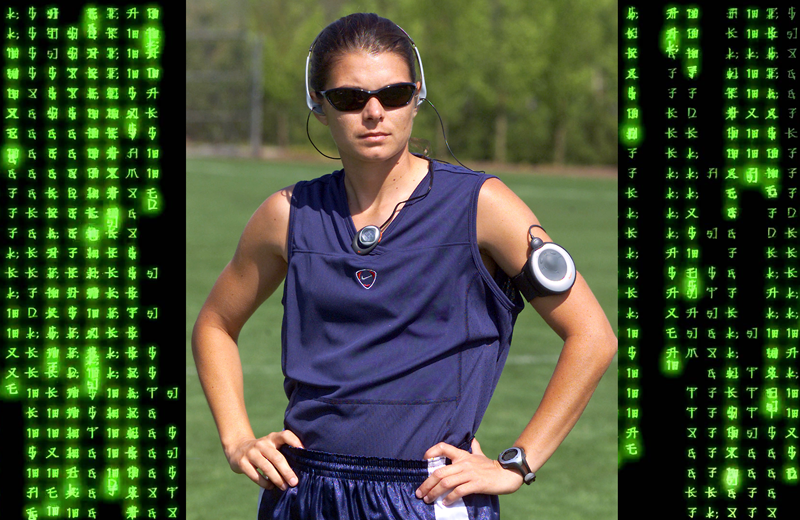Sport technology: not always better for performance?

The relentless march of digital technology and the rapid progress in artificial (machine) intelligence – more commonly known as AI – appears, for better or for worse, unstoppable. Unless you’re someone who deliberately tries to avoid these technologies, there are few aspects of our daily lives that now seem to be without it. Nowhere is this truer than in training, where athletes now have access to a plethora of accurate and affordable electronic monitoring, testing and feedback devices. From simple bike computers to GPS devices and power metering systems, it’s never been easier to monitor your performance and collect data to help you plan your future training sessions.
Does technology always benefit athletes?
With so much information so readily available, it’s natural to assume that something like pacing a time trial or tailoring a strength-training session without the use of digital monitoring and feedback information will put athletes at a distinct disadvantage. Surprisingly however, it’s by no means as clear cut as you might assume.
For example, some research on cyclists and electronic feedback carried out in 2016 (which we reported at the time) found that providing this feedback didn’t necessarily improve performance(1). In this study researchers decided to investigate how experienced cyclists performed a time trial with and without the aid of commonly used feedback from electronic devices – eg speed, heart rate, power output, cadence, elapsed time, and elapsed distance. The researchers wondered whether without this digital feedback, the cyclists would find it more difficult to regulate, distribute, and manage their effort, resulting in poorer performances.
Their curiosity was piqued by the fact that previous research had found that an athlete’s prior experience and accurate knowledge of the task demands are what’s really crucial to success(2), and also that in cyclists performing cycling time trials, performance did not seem to differ when accurate or inaccurate split-time feedback was given during the trial(3). Importantly, prior to 2016, no endurance exercise studies had been carried out demonstrating the necessity of the presence of in-race instantaneous task-related feedback that is nowadays commonly available via external devices (eg bike computer, running watch, power output meters etc)
Time trial research
To put this to the test, 20 performance-matched cyclists were randomly divided into one of two groups and asked to perform a 20km time trial as fast as they could. These two groups were:
- Group A, who didn’t receive any feedback during the time trial
- Group B, who were able to continuously consult various feedback information, which consisted of speed, heart rate, power output, cadence, elapsed time, and elapsed distance during their time trial
After the time trial, the researchers analysed the results to see what differences there were in terms of performance and other parameters.
of the cyclists using feedback were not significantly better than from the no-feedback group, nor was there any real difference between the average power outputs per kilo of body mass of the two groups (see figure 1). It was true that the cyclists with access to feedback did put a spurt in at the end of the time trial (presumably because they knew exactly how much distance remained and were able to time this spurt appropriately), but this didn’t enhance the overall performance. Moreover, the perceived ratings of exertion for the time trial were the same regardless of whether the cyclists had feedback or not.
Figure 1: Time trial performance with and without electronic feedback
You need to be logged in to continue reading.
Please register for limited access or take a 30-day risk-free trial of Sports Performance Bulletin to experience the full benefits of a subscription. TAKE A RISK-FREE TRIAL
TAKE A RISK-FREE TRIAL
Newsletter Sign Up
Testimonials
Dr. Alexandra Fandetti-Robin, Back & Body Chiropractic
Elspeth Cowell MSCh DpodM SRCh HCPC reg
William Hunter, Nuffield Health
Newsletter Sign Up
Coaches Testimonials
Dr. Alexandra Fandetti-Robin, Back & Body Chiropractic
Elspeth Cowell MSCh DpodM SRCh HCPC reg
William Hunter, Nuffield Health
Keep up with latest sports science research and apply it to maximize performance
Today you have the chance to join a group of athletes, and sports coaches/trainers who all have something special in common...
They use the latest research to improve performance for themselves and their clients - both athletes and sports teams - with help from global specialists in the fields of sports science, sports medicine and sports psychology.
They do this by reading Sports Performance Bulletin, an easy-to-digest but serious-minded journal dedicated to high performance sports. SPB offers a wealth of information and insight into the latest research, in an easily-accessible and understood format, along with a wealth of practical recommendations.
*includes 3 coaching manuals
Get Inspired
All the latest techniques and approaches
Sports Performance Bulletin helps dedicated endurance athletes improve their performance. Sense-checking the latest sports science research, and sourcing evidence and case studies to support findings, Sports Performance Bulletin turns proven insights into easily digestible practical advice. Supporting athletes, coaches and professionals who wish to ensure their guidance and programmes are kept right up to date and based on credible science.









